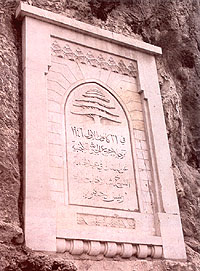 |
          |
 |
 |
 |
 Business
& Business
&  Community
Services Community
Services
 |
|
| |
|
|
 |
|
|
|
(History
Carved in Stone 15 km)
The historical inscriptions found at the mouth of the
Nahr-el-kalb (Dog River, the Lycus of the Romans) represent a
unique combination of history and geography. In distant
antiquity the steep cliffs here made it an impassable barrier.
Later the Assyrians and Romans managed to overcome the
difficulty by building a road and a bridge. In modern times
the Lebanese blasted a tunnel through the rock to accommodate
the coastal highway, changing forever the historic aspect of
the site.
The Mamluke Period bridge seen today has
been reconstructed several times, most recently by Emir Bashir
Chehab II in 1809. The other bridge, with three arches, was
built by Wassa Pasha, mutassarrif of Mount Lebanon between
1883 and 1892. |
|

|
|
A total of 17 plaques has been traced, all on the south bank
except for one on the north bank. The single stele on the
opposite side of the river was the work of the Neo-Babylonian
king Nebuncadnezzar II (604-562 BC). Rameses II left no less
than three inscriptions between 1290 and 1224 BC, when he
marched into Phoenicia. Five steles mark expeditions made by
Assyrian kings, one of whom was Assarhaddon (680-627 BC). In
Roman times the third Gallic Legion under Emperor Caracalla
(211-217 AD) left a stele marking road work carried out here.
There are two inscriptions in Greek. One is
illegible but the other commemorates more road and engineering
work. This was accomplished in 382 by Proclus, Byzantine
governor of Phonecia under Theodose the Grand (388-395).
Another stele commemorates the expedition that Napoleon III
sent to Lebanon in 1860-1861.
Among the 20th century inscriptions, one
records that French troops under General Gouraud took Damascus
in 1920. Two others dated 1919 and 1930 report that the
British Desert Corps took Damascus, Homs and Aleppo in October
1918. The British and French occupation of Beirut and Tripoli
in October 1918 is recorded as well.
Besides the 17 steles left before Lebanon's
independence, there is one marking the Evacuation of foreign
armies from Lebanon on December 31, 1946, and another
commemorating the French war dead. |
|
Back to top |
|

|
|
|
|
|





